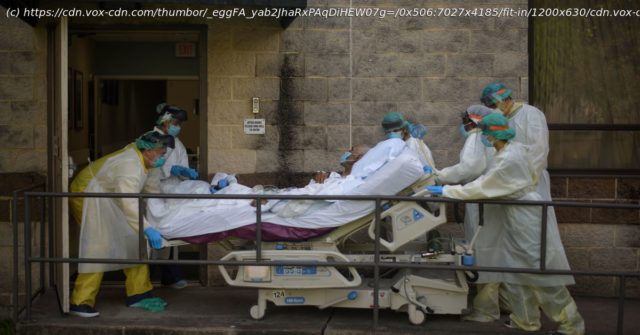By the time coronavirus deaths start rising again, it’s already too late.
There is something confounding about the US’s new coronavirus spikes: Cases are rising, but the country is seeing its lowest death counts since the pandemic first exploded.
The numbers are genuinely strange to the naked eye: On July 3, the US reported 56,567 new Covid-19 cases, a record high. On the same day,589 new deaths were reported, continuing a long and gradual decline. We haven’t seen numbers that low since the end of March.
When laypeople observe those contradictory trends, they might naturally have a follow-up question: If deaths are not increasing along with cases, then why can’t we keep reopening? The lockdowns took an extraordinary toll of their own, after all, in money and mental health and some lives. If we could reopen the economy without the loss of life we saw in April and May, then why shouldn’t we?
I posed that very question to more than a dozen public health experts. All of them cautioned against complacency: This many cases mean many more deaths are probably in our future. And even if deaths don’t increase to the same levels seen in April and May, there are still some very serious possible health consequences if you contract Covid-19.
The novel coronavirus, SARS-Cov-2, is a maddeningly slow-moving pathogen — until it’s not. The sinking death rates reflect the state of the pandemic a month or more ago, experts say, when the original hot spots had been contained and other states had only just begun to open up restaurants and other businesses.
That means it could still be another few weeks before we really start to see the consequences, in lives lost, of the recent spikes in cases. And in the meantime, the virus is continuing to spread. By the time the death numbers show the crisis is here, it will already be too late. Difficult weeks will lie ahead.
Even if death rates stay low in the near term, that doesn’t mean the risk of Covid-19 has evaporated. Thousands of Americans being hospitalized in the past few weeks with a disease that makes it hard to breathe is not a time to declare victory. Young people, who account for a bigger share of the recent cases, aren’t at nearly as high a risk of dying from the virus, but some small number of them will still die and a larger number will end up in the hospital. Early research also suggests that people infected with the coronavirus experience lung damage and other long-term complications that could lead to health problems down the road, even if they don’t experience particularly bad symptoms during their illness.
And as long as the virus is spreading in the community, there is an increased risk that it will find its way to the more vulnerable populations.
“More infected people means faster spread throughout society,” Kumi Smith, who studies infectious diseases at the University of Minnesota, told me. “And the more this virus spreads the more likely it is to eventually reach and infect someone who may die or be severely harmed by it.”
This presents a communications challenge. Sadly, as Smith put it, “please abstain from things you like to benefit others in ways that you may not be able to see or feel” is not an easy message for people to accept after three-plus months in relative isolation.
But perhaps the bigger problem is the reluctance of our government to take the steps necessary to control the disease. Experts warned months ago that if states were too quick to relax their social distancing policies, without the necessary capacity for more testing or contact tracing, new outbreaks would flare up and be difficult to contain.
That’s exactly what happened — and now states are scrambling to reimpose some restrictions. Unless the US gets smarter about its coronavirus response, the country seems to doomed repeat this cycle over and over again.
The contradiction between these two curves — case numbers sloping upward, death counts downward — is the primary reason some people are agitating to accelerate, not slow down, reopening in the face of these new coronavirus spikes.
The most important thing to understand is that this is actually to be expected. There is a long lag — as long as six weeks, experts told me — between when a person gets infected and when their death would be reported in the official tally.
“Why aren’t today’s deaths trending in the same way today’s cases are trending? That’s completely not the way to think about it,” Eleanor Murray, an epidemiologist at Boston University, told me. “Today’s cases represent infections that probably happened a week or two ago. Today’s deaths represent cases that were diagnosed possibly up to a month ago, so infections that were up to six weeks ago or more.”
“Some people do get infected and die quickly, but the majority of people who die, it takes a while,” Murray continued. “It’s not a matter of a one-week lag between cases and deaths. We expect something more on the order of a four-, five-, six-week lag.”
As Whet Moser wrote for the Covid Tracking Project last week, the recent spikes in case counts really took off around June 18 and 19. So we would not expect them to show up in the death data yet.
“Hospitalizations and deaths are both lagging indicators, because it takes time to progress through the course of illness,” Caitlin Rivers at the Johns Hopkins Center for Health Security told me late last week. “The recent surge started around two weeks ago, so it’s too soon to be confident that we won’t see an uptick in hospitalizations and deaths.”
The national numbers can also obscure local trends. According to the Covid Tracking Project, hospitalizations are spiking in the South and West, but, at the same time, they are dropping precipitously in the Northeast, the initial epicenter of the US outbreak.






